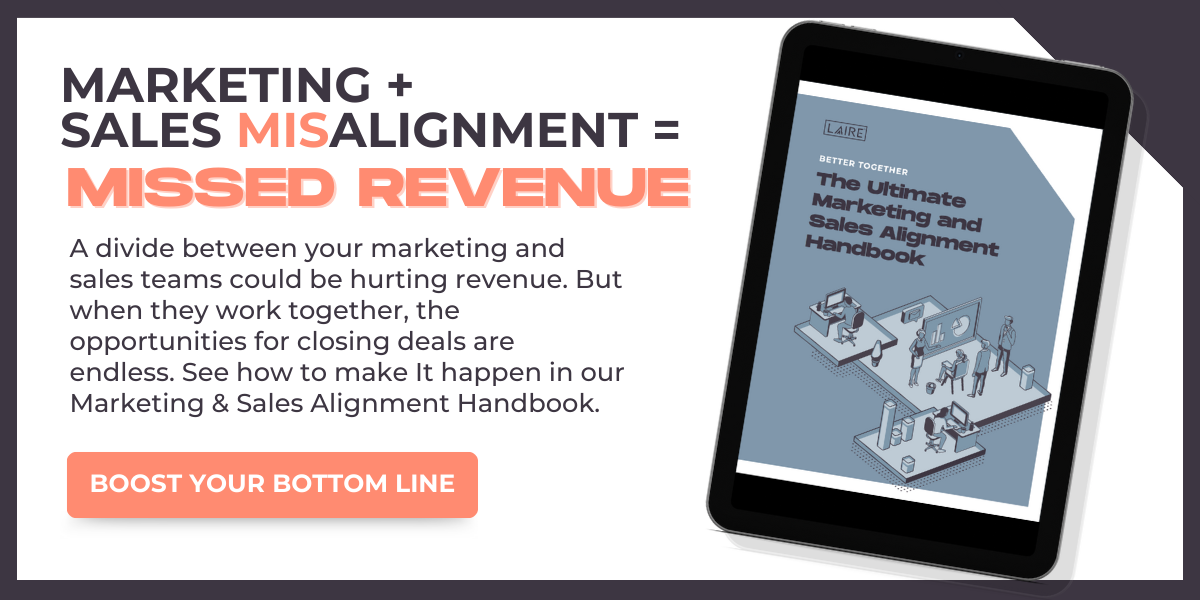Companies, particularly B2B firms, are so accustomed to operating with friction between sales and marketing they have become numb to the negative effect this has on business performance. The CEO is often insulated from the day-to-day pain that misalignment causes. I believe if the costs of misalignment were better understood, every CEO would put marketing and sales alignment on their list of mission-critical initiatives for the next six months. This article will suggest how to put a number on the misalignment.
Why Isn’t Alignment a Top Priority for Some?
If your company doesn’t think alignment in sales and marketing is important or possible, how could that be?
Too many top managers have become resigned to the situation. It’s easier to believe that sales and marketing are two different animals that shouldn’t share the same corral, than it is to address the situation with purpose and commitment. Hey, oil and water don’t mix, right?
Why Alignment Matters
Before we look at how to calculate the cost of misalignment, I think it’s useful to clarify why we should care. Why is alignment important within the revenue engine of the company? When you look past the theory and philosophy of it, what are the cold hard facts?
Research has shown that companies with well-aligned sales and marketing processes out-perform companies who haven’t figured out the alignment puzzle. In 2009 a benchmark global survey of nearly 1400 firms showed that aligned companies were growing 5.4 points faster than other companies in their industry; they were 38% better at closing proposals; and they churned 36% fewer customer each year. What would your P&L statement look like if you could match these improvements in performance?
In 2014, another global study looked to shed light on the same topic of why some companies out-perform others. One statistic is particularly telling. In those companies where sales and marketing actually plan together there is a 30% higher win rate for proposals and a 62% higher contribution to new business revenue by Marketing. Planning together is one key element of alignment. What would a 30% increase in win rates do for your financial statement?
Interested in the impact of alignment yet? Wait until you see how much misalignment is costing you.
Sales & Marketing Alignment Poll
Is Lack of Alignment Between Sales & Marketing Hurting Company Performance
- Don't know
- A little, but we're working on it.
- A lot, and we're struggling for the right solution.
- No, we're well aligned.
- Other
The Costs of Misalignment
Until the CEO, COO and CFO understand the costs of misalignment and the potential rewards of a smoothly running revenue engine, it will be difficult to prioritize and fund an alignment initiative.
How can you go about calculating the costs, considering both hard and soft costs are at play?
A back-of-the-envelope calculation should suffice to give an initiative a green light and a preliminary budget.
To start I suggest looking at seven cost categories under Culture and seven cost categories under Processes. Look at the hard and soft costs; don’t forget to consider opportunity costs, too.
Process Costs
Misaligned or unaligned processes in sales and marketing cause havoc and inefficiency. Companies that are misaligned experience some or all of the situations below. The costs can be considerable. For example, what are the costs associated with chronic sales forecast inaccuracy? It can lead to people losing their jobs. If a window is missed for the effective introduction of a new product, what are the costs if a competitor beats you to market? If you’re chasing poorly qualified leads, what are the costs of the wasted time? If a campaign or website has to be redone because marketing and sales weren’t on the same page strategically, what are the costs?
You get the picture I’m sure. You can probably add other situations to the list below. That’s fine; the goal is come up with a guestimate of the annual costs. Write the figure down.
- Cost of customer acquisition too high
- Sales cycle too long
- Inaccurate sales forecast
- Ineffective marketing spend
- Tactic or campaign do over’s
- Cost per lead too high
- Time to market is too long
Culture Costs
Misalignment causes friction. Friction grinds away at people. Friction removes the incentive for high performance and innovation. Therefore, it’s important to look at the cultural costs. How many of the following situations exist now or have occurred in your Sales and Marketing departments?
- Staff churn
- Missed revenue & profit targets
- Reduced agility
- Reduced responsiveness
- Impacts customer relationships
- Lack of coordination
- Mistakes
Some of these like Reduced Agility and Reduced Responsiveness can at first glance be difficult to measure. Take another look. Is it taking longer than necessary for Sales and Marketing to agree to a plan and implement the plan? If your Sales and Marketing organization costs $100k a week for example and a plan requires five weeks to produce and launch, when it should take four weeks, that’s $100k spent unnecessarily. Multiple the excess cost times the number of plans and revenue campaigns in a year and you’re talking about serious money down the drain, not to mention spending too much time planning rather than doing.
How many rock stars in Marketing or Sales have left your company because they felt the environment was not conducive to high performance? Or, how many rock stars couldn’t be recruited successfully because they saw during the interviews that Marketing and Sales were not on the same page?
Calculate the costs for a year of the seven cultural situations (and whatever others you want to add) caused by misalignment in Sales and Marketing.
Even small companies with total revenues under $10M are going to see the Process and Cultural costs of misalignment approach 1%-5% of sales—certainly enough to warrant key initiative status (and a budget to match the level of importance).
Aligning the Tires
Alignment of Sales and Marketing is possible if the CEO is championing the initiative, and if the CEO is relying on objective outside expertise to rally the two groups around unified processes, definitions, strategies and a common view of the customer. Instilling a culture of accountability, respect and openness is also required. It’s the perfect assignment for an interim executive who can earn the trust and respect of those in both Sales and Marketing.



